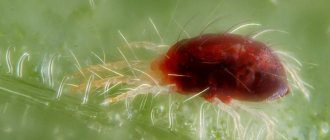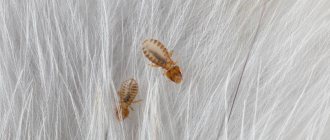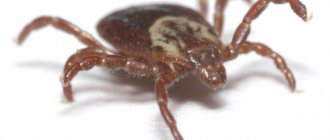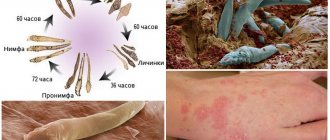Long before the onset of sunny spring days, a vaccination campaign against viral tick-borne encephalitis is being launched in the country. It is especially important for residents of areas where this disease is endemic. During 2021, 4,402 more cases of tick bites were registered in Russia than in 2021 and 12.6% higher than the long-term average data (in 2013–2017).
Let's consider where you can become infected with tick-borne encephalitis, in which areas of the country this danger is greatest, when it is necessary to vaccinate and what kind of vaccines are used.
What is tick-borne encephalitis
This is an acute viral infection. It has a natural focal nature, since a person becomes infected from an insect or animal.
The main mechanism of transmission of the pathogen in tick-borne encephalitis is transmissible. Infection occurs through the bite (suction) of an arthropod. There is a chance of getting sick from eating raw milk from goats, or, less commonly, cows. The danger arises during periods of increased tick activity. Infection can also occur by crushing and rubbing an attached insect. Transplacental transmission from mother to fetus is possible.
The causative agent of the disease is an RNA virus. When boiled, it collapses within two minutes. Affects the human central nervous system.
Clinical picture
The incubation period for transmissible transmission lasts 7-14 days, for nutritional transmission - 4-7 days.
The clinical picture of tick-borne encephalitis of the European subtype is characterized by biphasic fever. The first phase lasts 2-4 days, it corresponds to the viremic phase. This stage is accompanied by nonspecific symptoms, including fever, malaise, anorexia, muscle pain, headache, nausea and/or vomiting. Then comes an eight-day remission, after which in 20-30% of patients there follows a second phase, accompanied by damage to the central nervous system, including meningitis (fever, severe headache, stiff neck) and/or encephalitis (various disturbances of consciousness, sensitivity disorders, motor disorders up to paralysis).
The Far Eastern subtype of tick-borne encephalitis is characterized by a more rapid course with a higher mortality rate. The disease begins with a sharp increase in body temperature to 38-39 ° C, severe headaches, sleep disturbances, and nausea begin. After 3-5 days, damage to the nervous system develops.
In the first phase, leukopenia and thrombocytopenia are detected in the laboratory. A moderate increase in liver enzymes (ALT, AST) in a biochemical blood test is possible. In the second phase, pronounced leukocytosis is usually observed in the blood and cerebrospinal fluid. The tick-borne encephalitis virus can be detected in the blood starting from the first phase of the disease. In practice, the diagnosis is confirmed by the detection of specific acute-phase IgM antibodies in the blood or cerebrospinal fluid, which are detected in the second phase.
What does an endemic area for tick-borne encephalitis mean?
The reservoir for the pathogen is ixodid ticks, which themselves become infected when they bite sick animals. More than 100 species of mammals and birds can transmit encephalitis. Within 5–6 days, the virus spreads in the arthropod’s body, accumulating in the intestines, salivary glands, and reproductive apparatus.
The causative agent of a dangerous disease was first isolated in 1937 by the Soviet virologist L.A. Zilber based on the results of an expedition to the taiga regions of the Far East. Therefore, the disease historically has several names - spring-summer, Far Eastern, taiga encephalitis.
For more than 80 years, scientists have identified three subtypes of the pathogen in Russia. The reservoir for the Far Eastern and Siberian virus is the taiga tick (Ixodes Persulcatus), and for the European one it is the dog tick (Ixodes Ricinus). All pathogens are representatives of the same type, but the prognosis after infection is different. More severe damage to the central nervous system is observed during intoxication with the Far Eastern strain, which is found in the territory of the same name in Russia.
The pathogen retains its toxicity for the life of the arthropod - from 2 to 4 years, and is passed on to generations. Thus, in the habitats of infected ticks, natural zones are formed where the risk of infection is higher than in other places. These are called endemic areas.
Natural foci are located in deciduous and mixed forests with dense undergrowth. The habitat of arthropods is meadows along the banks of rivers, lakes, clearings, and roadside vegetation. Such areas may be located far from human habitation, because ticks need a source in the form of wild animals and birds. Sometimes anthropurgic (related to a person’s work or housing) foci form. Goats, sheep, and cows also become targets for tick infection.
Treatment of the consequences of tick-borne encephalitis
During the acute period of the disease, strict bed rest is necessary. The main treatment is donor antiencephalitis immunoglobulin and interferons. The doctor selects a treatment regimen depending on the severity of the manifestations, the period from the moment of the bite and the weight of the patient.
After discharge from the hospital, which is possible no earlier than 2 weeks after the temperature has normalized and there are no neurological symptoms, the patient should be under regular outpatient supervision by a neurologist for at least one year, and sometimes for life.
It is impossible to treat tick-borne encephalitis only with folk remedies, since the risk of complications is too high. At the same time, to strengthen the immune system, you can use an infusion of pine needles with aspen bark. To prepare it, 1 tbsp. spoon of pine needles and 1 tbsp. pour a spoonful of finely ground bark into 0.5 liters of boiling water and leave for an hour. Take warm, 1 glass 8 times a day.
Royal jelly has proven itself well as a general tonic, which is dissolved at 20-30 mg 3-5 times a day an hour before meals. It is commercially available in the form of powder or tablets. Sometimes it is added to honey, stirring in a ratio of 1:100. Take 1/2 teaspoon of this mixture. Course until complete recovery.
The antiviral properties of garlic and onion phytoncides have long been known. They need to be finely chopped (separately or together) and inhaled for about 30 seconds 5-6 times a day. To improve blood circulation, treat noise in the head, headaches and hearing loss, garlic is consumed orally. You can prepare a mixture of crushed garlic with lemon, honey and olive oil in a ratio of 2:2:1:4. Infuse the mixture in the refrigerator for 10 days and consume 1 tbsp. spoon 3-4 times a day before meals for a month. If necessary, the course is repeated after 2 weeks.
Alcohol tincture of periwinkle helps improve brain function and microcirculation. To prepare it, take 10 g of chopped fresh herbs, add 100 ml of 70% alcohol, and leave for 20 days in a dark place at room temperature. Take 10 drops 3 times a day before meals, diluting with water, for 3-6 months.
Disadvantaged areas
Areas that pose a risk of infection with tick-borne encephalitis for humans have been identified in more than twenty countries around the world. Every year, in 25 European and 7 Asian countries in northern Eurasia, up to 14 thousand cases of infection with the development of clinical symptoms are registered. According to the 2011 WHO Memorandum, the highest incidence is observed in the Baltic countries, Slovenia and the Russian Federation. But rates can vary significantly even within the same geographic region.
WHO has issued recommendations for immunization of the population of areas unfavorable for tick-borne encephalitis. The vaccination strategy is based on the average incidence of disease before vaccination. Considered high and requiring immunization of people of all ages, including children, the rate is more than 5 cases per 100,000 population per year.
Regions of Russia endemic for tick-borne encephalitis
The Federal Service for Surveillance on Consumer Rights Protection and Human Welfare published a document dated January 2021 on its website.
| List of subjects endemic for tick-borne encephalitis | Number of districts |
| Ivanovo region | 3 |
| Kostroma region | all areas |
| Moscow region | 2 |
| Tver region | 12 |
| Yaroslavl region | 18 |
| Arhangelsk region | 18 |
| Vologda, Kaliningrad regions | all areas |
| Republic of Karelia | 13 |
| Komi Republic | 8 |
| Leningrad, Novgorod, Pskov regions | all areas |
| Saint Petersburg | 6 |
| Republic of Crimea | 10 |
| Sevastopol | all areas |
| Kirov region | All areas |
| Nizhny Novgorod Region | 31 |
| Orenburg region | 7 |
| Perm region | all areas |
| Republic of Bashkortostan | 42 |
| Mari El Republic | 11 |
| Republic of Tatarstan | 30 |
| Samara Region | 26 |
| Udmurt republic | all areas |
| Ulyanovsk region | 5 |
| Sverdlovsk region | all areas |
| Tyumen region | all areas |
| Khanty-Mansiysk Autonomous Okrug - Ugra | 19 |
| Chelyabinsk region | all areas |
| Altai, Altai region | all areas |
| The Republic of Buryatia | 18 |
| Irkutsk region | 30 |
| Kemerovo region | all areas |
| Krasnoyarsk region | 57 |
| Novosibirsk region | 23 |
| Omsk region | 16 |
| Tomsk region | all areas |
| Tyva Republic | 13 |
| The Republic of Khakassia | 10 |
| Transbaikal region | 24 |
| Amur region | 16 |
| Jewish Autonomous Region | all areas |
| Primorsky Krai | all areas |
| Sakhalin region | 15 |
| Khabarovsk region | 16 |
In the Moscow region there are two areas dangerous for tick-borne encephalitis - Dmitrovsky and Taldomsky. In 2021, 14 imported cases of the disease were registered in Moscow. In 12 patients, infection occurred in endemic areas of Russia, in two in foreign countries.
Incidence by regions of Russia
According to weekly operational monitoring conducted by Rospotrebnadzor institutions in the regions of the Russian Federation, 1,508 cases of the disease were registered in 2018, which were distributed across 46 constituent entities. 44.3% of registered cases of tick-borne viral encephalitis were noted in the Siberian Federal District. The indicators on its territory exceeded those in the country by 3.4 times.
In other federal districts, cases of infection were distributed as follows:
- Privolzhsky - 22%;
- Ural - 14.7%;
- Northwestern - 12.6%;
- Central - 3.7%;
- Far Eastern - 1.7%.
63.9% of all registered cases occurred in 10 subjects of Russia - Krasnoyarsk, Perm Territory, Kirov, Kemerovo, Novosibirsk, Sverdlovsk, Tyumen, Irkutsk, Vologda, Chelyabinsk regions.
How does infection occur?
Tick-borne encephalitis is a seasonal disease. For Ixodes Persulcatus, the period of activity is May and June. And Ixodes Ricinus is characterized by two peaks per season - the beginning and end of summer, that is, May, June and August, September.
These are periods of active work on agricultural land, gardens and personal plots. In spring and summer, the movements of tourists relaxing in the lap of nature become more active. Even a walk in an urban area through a park or alley can lead to tick bites. Once on the skin, the arthropod makes a small incision, generously moistening it with saliva, and injects an anesthetic. More than 10 hours may pass from the moment of suction to the appearance of unpleasant sensations.
The incubation period averages 1–2 weeks. In the febrile form, the disease begins acutely and resembles the flu. The victim complains of hyperthermia (high body temperature), painful headaches, nausea, and vomiting.
A complicated course and unfavorable prognosis are characteristic of the meningeal and encephalitic (focal) forms. The viral infection has a toxic effect on the central and peripheral nervous system and is complicated by paralysis of the limbs. In 1–3% of patients, the disease becomes chronic. Mortality figures depend on the strain and range from 2% for the European form to 20% for the Far Eastern form.
Symptoms of tick-borne encephalitis in adults. Incubation period
The disease usually begins 10-14 days after the bite. Sometimes the incubation period ranges from several days to one, extremely rarely two months. The first manifestations of the disease: high body temperature, usually 39-40C, with severe headache, nausea, loss of appetite, weakness, lethargy, pain in the back, lower back, aching arms and legs. Patients often complain of sleep disturbances and photophobia. Repeated vomiting is possible. The face, neck and chest are usually flushed. Blood pressure and heart rate, despite the increased temperature, decrease. Fever is difficult to treat with antipyretics. As with other viral diseases, antibiotics have absolutely no effect.
Deterioration of vision, hearing, numbness of the arms and/or legs, and convulsions are possible quite quickly. An increase in symptoms with the appearance of neurological disorders occurs within 3-7 days. Even despite adequate therapy, complete paralysis of any part of the body, disturbances of consciousness and even coma are possible. In some patients, the disease manifests itself as psychomotor agitation, delusions, hallucinations, and loss of orientation in time and space.
The patient must be urgently hospitalized, since there is a high risk of cerebral edema and respiratory arrest. Only timely intensive therapy with antiviral and neurotropic drugs against the background of detoxification and dehydration can save life or prevent complete disability.
The duration of the disease ranges from one week with a favorable or erased course to a month or more with moderate and severe forms. Then comes a period of residual manifestations. Their severity depends both on the individual sensitivity of the body, the amount of viruses received during the bite, and on the timeliness and correctness of the therapy.











